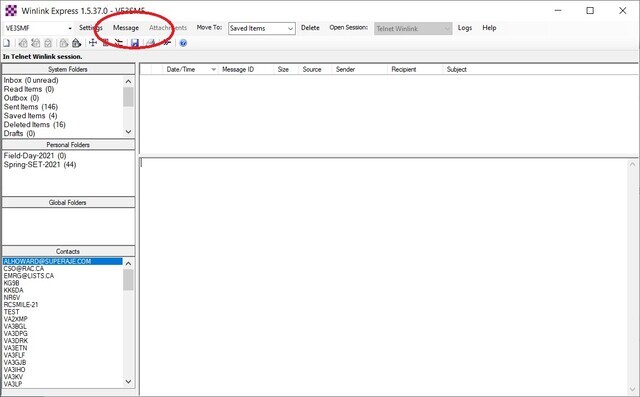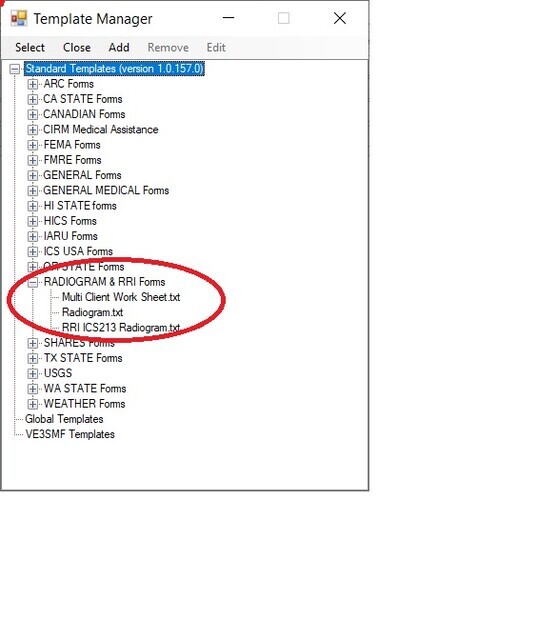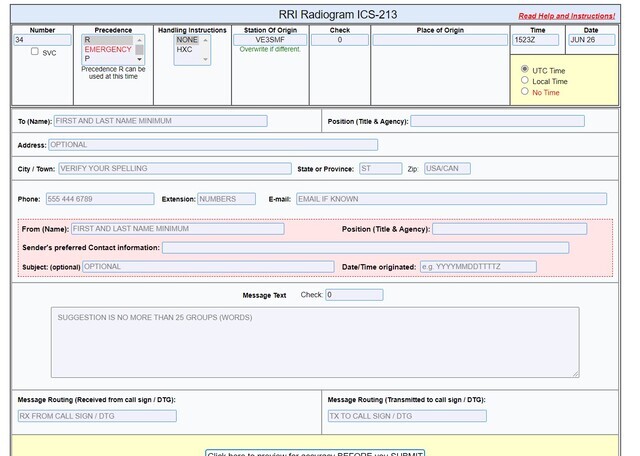Fwd: Field Day 2021 how to send radiogram to SM #TrainingExercise
Robert Galambos DEC CEC VA3BXG
Field Day 2021
Note: the Radiogram needs to be sent by RF using Winlink from field day site. No internet please. You can use Winlink to send the message through a gateway with a regular e-mail address to the SM, if they are not active on Winlink.
7.3. Bonus Points: All stations are eligible for certain bonus points, depending on their entry class. The following bonus points will be added to the score, after the multiplier is applied, to determine the final Field Day score. Bonus points will be applied only when the claim is made on the summary sheet and any proof required accompanies the entry or is received via email or normal mail delivery.
7.3.5. Message Origination to Section Manager: 100 bonus points for origination of a formal message to the ARRL Section Manager or Section Emergency Coordinator by your group from its site. You should include the club name, number of participants, Field Day location, and number of ARES operators involved with your station. The message must be transmitted during the Field Day period and a copy of it must be included in your submission in standard ARRL radiogram or no credit will be given. The message must leave or enter the Field Day operation via amateur radio RF. The Section Manager message is separate from the messages handled in Rule 7.3.6. and may not be claimed for bonus points under that rule. Available to all Classes.
How do I find my Section manager?
In the Radio Amateurs of Canada (RAC) publication The Canadian Amateur (TCA) on page 4 is always the sorta current list of RAC Section Managers in a grey box. his will give the "last known address and contact for your Section Manger (SM).
This address information goes into the Radiogram to be sent.
With Winlink, how do I send a message and which form do I use?
From the main Winlink Express screen, select:- Message.
- New Message
- Select Message
- Select Template
- Select Standard Templates
- Select RADIOGRAMS & RRI forms.Image 1: Starting point, follow above prompts.
At the RADIOGRAMS & RRI forms you can select either:
- Radiogram.txt
- RRI ICS213Radiogram.txt
Image 2:
Select the radiogram and fill in all the data required. Note the 25 word limit. The address can be sent as per the RAC TCA address on page 4.
Image 3: Radiogram.txt template. Complete as required.
Information for the form....
Overview
The Winlink Express Amateur Radio Radiogram Text Creator was developed as a partnership between Radio Relay International and the Winlink Development Team. Its purpose is to provide a structured forms-based approach to producing a correctly formatted radiogram with a text output that appears in the Winlink Express New Message panel. The completed radiogram can then be sent to a Winlink-RRI Liaison Station. That station will then inject the radiogram into the traffic system.
Printed copies of a Client Worksheet can be handed out to facilitate template entry, when you have many wishing to send a Radiogram. This worksheet is an HTML, that you can open and then copy/paste to any text editor. It is located in the same folder as the Radiogram. Just click on "Multi Client Work Sheet.txt".
A radiogram is simply a telegram message that is sent by a radio-only network that is comprised of amateur radio operators. These interoperable networks are sponsored by the ARRL (National Traffic System or NTS) and by Radio Relay International (RRI). The networks use phone, cw and digital modes. The cw and phone nets operate through a precisely sequenced and layered system of nets that cover local, section, region, area and transcontinental relays. The digital system consists of a mesh network configuration of automated Pactor hubs that are accessed by appointed Digital Traffic Station operators.
The system is in final stages to be able to handle bulk disaster communications out of an affected area, but can be activated upon request in the interim, see comments in green below. It is in operation 24/7, handling a variety of personal greetings as well as exercise traffic. Thousands of messages are handled on a weekly basis and the networks welcome traffic. Examples include congratulatory messages, thanks for the QSO messages, happy birthday messages, etc. Also, a number of hams have established penpal relationships with hams and even non-ham friends and family members.The Radiogram Format
The radiogram format has been in existence since 1949 and is very similar to the old commercial Western Union telegram as well as contemporary military formats.
The radiogram has 4 primary sections:
- The first line is the preamble and includes the message number (assigned by the originating station), precedence (importance i.e. Routine, Welfare, etc.), handling instructions for the delivering station (e.g. HXC is a request for delivery confirmation from the delivering station), originating stations call sign, check (number of words/groups in the message body), town, state and date of origination. Note: If doing a message relay back into the system, be sure to use the original message number. The SVC check box is for NTS handler use for servicing back a message. Time is a user option.
- The preamble is followed by the recipients address and contact information. It is very important to note that routing through the entire system is based on the recipients USA or Canadian postal code, state and town The street address and phone number (10 digits only 555 555 5555) and other information are used by the delivering station. The deliverer is a human who can exercise different methods as might be appropriate to complete the delivery. Also need a phone number, email, or both to ensure delivery. Keep in mind that sending INTO a disaster a welfare check is not recommended, as delivery will be most likely impossible. Sending outbound "I am OK and status" traffic from a shelter or any disaster venue is a good use of the Radiogram.
- The message body is enclosed between breaks (BT). For compatibility with all transmission modes, the radiogram uses a limited character set, as is true throughout the radiogram. The period character is interesting as there are several uses. A period at the end of a sentence becomes an X. A decimal point is R, such as 146R750 The ".com in an email address is DOT COM. Other substitutions include QUERY for the question mark, ATSIGN for @, UNDERSCORE for _. The slant bar (slash) / is a permitted character. Telephone numbers are 10 digits - area code, exchange and number with no dashes. An entered extension is numbers only and will add EXT to the front. The / (stroke) can be entered and will remain as a /.
The Text Creator assists with all of this by making the substitutions for you, or not allowing certain characters.
- The last section is the signature of the sender. All radiograms must have a signature, (name). In the case of 3rd party messages, the signature is that of the person who provided the message - not the originating stations ham radio operator.
The first OP NOTE is for special instructions to the traffic handlers. This could be a note that the addressees phone number is a daytime work number, additonal delivery instructions, etc.
The last OP NOTE can be for return handling instructions, notes you feel are applicable to pass on. Please keep OP NOTES brief!
If indicating a return email to obtain a delivery notification (SVC) do not use a Winlink address. You do not know if the final traffic handler is in your whitelist. Remember while you are using Winlink to input the traffic, the next delivery route may not be Winlink, it could be CW or voice.Getting the Message into the System
The traditional way to get a message into the network is to check into a local or section traffic net and transmit the message by voice or cw. As a Winlink operator, you will need to get your message to a Winlink-RRI Liaison Station. These are listed as tactical addresses in the drop down at the bottom of the form. When you are ready to send your message, select the Liaison Region that is associated with the addressee's location.Note: During the introductory phase of injecting messages into the traffic network by this template, not all of the procedures or personnel have been put in place to handle traffic with a precedence of EMERGENCY.
However if an event or disaster occurs that warrants originating EMERGENCY precedence traffic, please notify the RRI National Emergency Communications Coordinator immediately to request activation of the RRI National Emergency Communications Response Plan at 269-650-0215 or inject a message requesting RRI emergency activation via an available IATN (Inter-Area Traffic Network) circuit, or to KB1...@winlink.org
References
The most up to date information on RRI and message handling is being provided by Radio Relay International http://radio-relay.org/The Traffic Operations Aid or Pink Card is a concise 2-page summary of radiogram formatting and transmission procedures for voice, cw and digital. Have a copy at your operating position as you enter a message into the Winlink Text Creator.
Direct link to the PDF: http://radio-relay.org/wp-content/uploads/2017/05/RRI-TRAFFIC-OPERATIONS-AID-1720r3.pdf
The RRI Publications page http://radio-relay.org/about/publications/ has a number of other useful guides and aids. Two of special note are the Traffic Operations Field Manual FM-001 and the RRI Training Manual TR-001.
Note: If you desire for future use and with no Interent there are free Zip code data bases available to install.
Questions or suggestions concerning the Radiogram template or its use, may be submitted via Winlink to KB1TCE
You can also use the RRI Radiogram.txt form
Image 4: RRI ICS213 Radiogram.txt
More details on the form:
Instructions for using the RRI ICS-213 Radiogram Text Creator
The RRI ICS-213 Radiogram Text Creator is designed to facilitate the transmission of ICS-213 messages in ra-diogram format. The text creator is based on the hard copy RRI Form 1701-ICS (ICS213 Compatible Radio-gram Message Form).
The radiogram format is a standard message form used by commercial, government, military, and amateur radio services worldwide. It not only includes all essential ICS-213 accountability data, but also appends additional network management data designed to ensure that messages remain intact as they pass between various communications networks. The addition of network management data ensures that reply messages, requests for clarification and similar administrative replies can be routed via the correct network(s) to the operator or station with access to the appropriate public safety official or other point-of-contact. The ICS-213 variant includes some other information that is part of the ICS-213 form.
Interoperability requires that one leverage all available communications assets to ensure maximum surviva-bility and flexibility. By following these simple guidelines, one can promote interoperability in an elegant and simple manner.
The purpose of the template is to provide a structured forms-based approach to producing a correctly formatted radiogram with a text output that appears in the Winlink Express New Message panel. The completed radiogram can then be sent to a Winlink-RRI Liaison Station. That station will then inject the radiogram into the traffic system at the appropriate level for routing to its destination.The ICS-213 radiogram has five primary sections. It only differs from the standard radiogram in that some additional information is requested. For example, Sender and Addressee Position (Title/Agency) are requested fields. Also, in accordance with the ICS-213 form’s layout, the sender’s information and optional subject are immediately after the addressee’s information. To avoid confusion, these areas are preceded by “TO” and “FROM” respectively in the text that appears in the Winlink Express New Message pane and in the transmitted text.
The first section is the single line preamble. This includes the message number (assigned by the originating station); precedence (importance, i.e. Routine, Welfare, Priority, etc.); handling instructions for the delivering station (e.g. HXC is a request for delivery confirmation from the delivering station); originating station’s call sign; check (number of words/groups in the message body); place or origin; and time and date of origination.
The second section is for the addressee’s name, position, address and contact information (telephone and/or email). It is very important to note that routing through the entire system is based on the addressee’s postal code, state and town The street address and phone number and other information are used by the delivering station. The deliverer is a human who can exercise different methods as might be appropriate to complete the last mile process of message delivery. This is especially important in disaster communications.
The third section has fields for the sender’s name, position and the time that the form was generated. The time field here is free text so that the agency’s preferred DTG format can be used. There is also a field for the optional Subject text.
The fourth section is the message body. This is enclosed between breaks (BT) in the transmitted text. For compatibility with all transmission modes, the radiogram uses upper case and a limited character set, as is true throughout the radiogram. The period character is interesting as there are several uses. A period at the end of a sentence becomes an X. A decimal point is R. ”.com” in an email address is “DOT COM.” Other substitutions include QUERY for the question mark, ATSIGN for @. The slant bar (slash) / is a permitted character. Telephone numbers are 10 digits - area code, exchange and number with no dashes. The Text Creator assists with all of this by making the substitutions for you.
As a rule, scientific terms, specialized abbreviations, or other case-sensitive terminology should be spelled-out, particularly when case reflects a multiplier value. For example; “1008 MILLIBARS” is preferable to “1008 MB.” This method also improves accuracy. Remember, the radiogram-ICS213 message may need to be transferred to an amateur voice circuit, a public safety talk group, a military voice circuit, or a radiotelegraph network to achieve the last mile connectivity to the official or agency to which it is addressed. Therefore, brevity of message text should always be a priority.
The fifth and final section consists of additional accountability information. These may be filled out by the originating and relay stations.
Getting the Message into the Network:
As a Winlink operator, you will need to get your message to a Winlink-RRI Liaison Station. These are listed as tactical addresses in the drop-down at the bottom of the form. When you are ready to send your message, select the Liaison Region that is associated with the addressee's location.
Saving the HTML Template:
If you want to save or print a copy of the HTML input version of the template, you must do this from your browser before clicking “Submit.” Once submitted, the HTML version will disappear. At this point, only the inputted data from the template will be saved. This appears in the Winlink Express message pane.
Further Information:
The hard copy (PDF) RRI Form 1701-ICS “ICS213 Compatible Radiogram Message Form” may be accessed at http://radio-relay.org/wp-content/uploads/2017/05/RRI-Form-1701-ICS-2017-5-1.pdf
For further information on disaster communications, message formats, network management and emergency communications planning, please reference the Radio Relay International National Emergency Communica-tions Response Guidelines at:
http://radio-relay.org/wp-content/uploads/2020/08/RRI-NECRP-2020-8-1-Final-Approved.pdfOne may also contact Radio Relay International at
:
in...@radio-relay.org - www.radio-relay.org - Follow us on Twitter @RadioRelayIntl.
Questions or suggestions concerning this template or its use, may be submitted via Winlink to KB1TCE.
VE3SMF Stuart
_._,_._,_
Groups.io Links:You receive all messages sent to this group.
View/Reply Online (#151) | Reply To Group | Reply To Sender | Mute This Topic | New Topic
Mute #trainingexercise
Your Subscription | Contact Group Owner | Unsubscribe [va3...@gmail.com]
_._,_._,_




